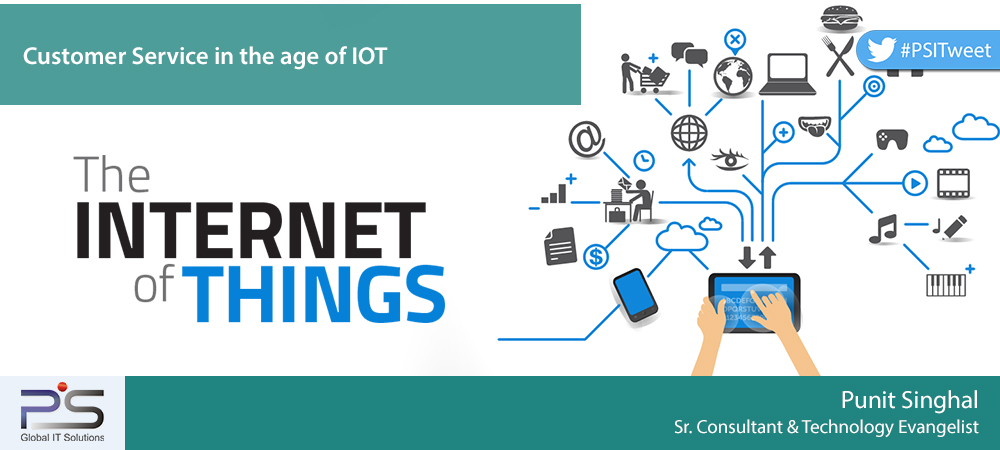Whether your customers are business enterprises or end users; focus should be to cater to your customer. A Gartner research reports that by 2020, the customers will manage 85% of their relationships with an enterprise without interacting with a human. So we have to re-think and innovate our service models. The innovative service models will be based on latest technology developments including IoT. Along with ‘smart products’ we will have ‘smart services’; IoT is much more than interconnected devices. It includes managing the services in totality for superior customer service delivery.
During initial days, customer service used to be face to face interaction with the customers, then came the telephone age where you had a customer care number to address your concerns. With increasing costs, these call centres were outsourced to developing countries where cultural differences at times, ruined the customer experience. Next in line came the interactive voice recorder (IVR) which confused and irritated the customer occasionally. The social media has acted as a vent to burst out the negative experiences customers face.
The emergence of IoT has paved a new platform to serve the customers and improve customer service experiences.
Customers love to be heard, they want enterprises to invite ideas and opinions from them. They want more independence and fewer interactions but an appropriate and quick resolution of their service concerns. The live video chat is another innovative medium that can be utilised in customer service.
We never thought of linking IoT and customer service together. But now, enterprises are exploring ways to diagnose and resolve service concerns with less human intervention. The automated service will result in better and faster personalised solution with lower costs. The improved service levels will in turn increase loyalty and customer base. The automated service processes with integrated applications will streamline the processes to solve the issues faster.
The IoT-enabled devices will be able to directly interact and support customer service through predictive analytics. The smart products will create new service opportunities with increased intelligence and connectivity levels. These will help the enterprises to analyse customer behaviour patterns, predict breakdown and malfunctions and provide real-time feedback. The improved products will affect customer satisfaction and loyalty levels. Moreover, the focus will shift from manufacturing to service industries.
Data analytics will create an intelligent support system to solve issues proactively using customer data (geolocation, usage and preferences).
The smart coffee dispenser will monitor the quantity of coffee in the machine, and will automatically place an order with the local store on the basis of customer preferences. The intelligence system will place a refill order well in advance and notify the user about the delivery schedule. The drastic change from ‘out of coffee’ to proactively solve the problem can be attributed to the smart connected devices.
IoT has created a new dimension in customer service processes by delivering personalised experiences. It has improved customer satisfaction and loyalty levels taking customer relationship to new heights.
By Punit Singhal, Sr. Consultant & a Technology Evangelist Whether your customers are business enterprises or end users; focus should be to cater to your customer. A Gartner research reports that by 2020, the customers will manage 85% of their relationships with an enterprise without interacting with a human. So we have to re think and innovate our service models. The innovative service models will be based on latest technology developments including IoT. Along with ‘smart products’ we will have ‘smart services’; IoT is much more than interconnected devices. It includes managing the services in totality for superior customer service delivery.
During initial days, customer service used to be face to face interaction with the customers, then came the telephone age where you had a customer care number to address your concerns. With increasing costs these call centres were outsourced to developing countries where cultural differences at times, ruined the customer experience. Next in line came the interactive voice recorder (IVR) which confused and irritated the customer occasionally. The social media has acted as a vent to burst out the negative experiences customers face.
The emergence of IoT has paved a new platform to serve the customers and improve customer service experiences.
Customers love to be heard, they want enterprises to invite ideas and opinions from them. They want more independence and less interactions but appropriate and quick resolution of their service concerns. The live video chat is another innovative medium which can be utilised in customer service.
We never thought of linking IoT and customer service together. But now, enterprises are exploring ways to diagnose and resolve service concerns with less human intervention. The automated service will result in better and faster personalised solution with lower costs. The improved service levels will in turn increase loyalty and customer base. The automated service processes with integrated applications will streamline the processes to solve the issues faster.
The IoT enabled devices will be able to directly interact and support customer service through predictive analytics. The smart products will create new service opportunities with increased intelligence and connectivity levels. These will help the enterprises to analyse customer behaviour patterns, predict breakdown and malfunctions and provide real time feedback. The improved products will affect customer satisfaction and loyalty levels. Moreover the focus will shift from manufacturing to service industries.
Data analytics will create intelligent support system to solve issues proactively using customer data (geo-location, usage and preferences).
The smart coffee dispenser will monitor the quantity of coffee in the machine, and will automatically place order with the local store on basis of customer preferences. The intelligence system will place a refill order well in advance and notify the user about the delivery schedule. The drastic change from ‘out of coffee’ to proactively solve the problem can be attributed to the smart connected devices.
IoT has created a new dimension in customer service processes by delivering personalised experiences. It hasimproved customer satisfaction and loyalty levels taking customer relationship to new heights.
By Punit Singhal, Sr. Consultant & a Technology Evangelist [:]









